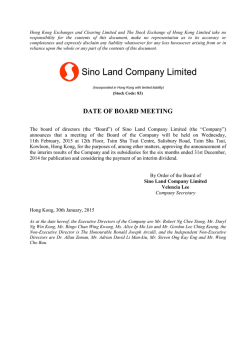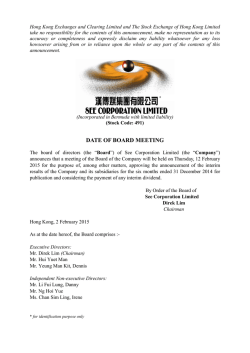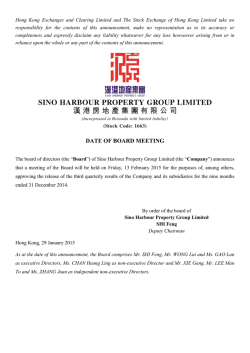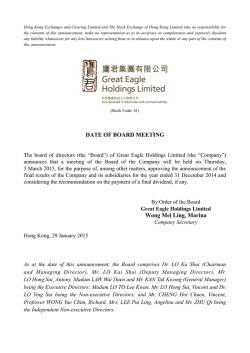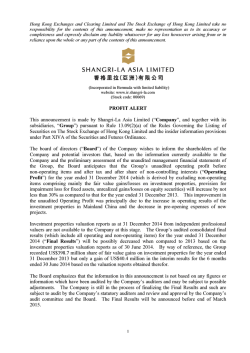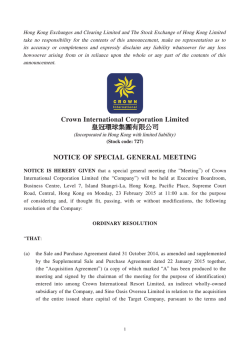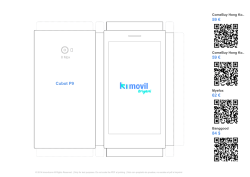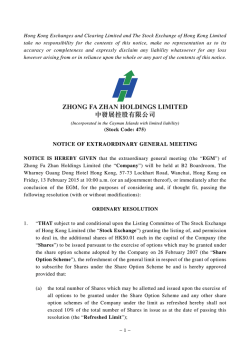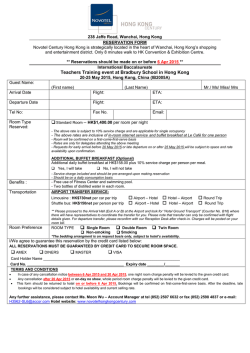
Hong Kong review
perspective JANUARY 2015 Increasing customer acquisition, penetration and retention by leveraging mobile financial services: Hong Kong review Mayank Parekh, Stefano Sorrentino, Piyush Maheshwari Increasing customer acquisition, penetration and retention by leveraging mobile financial services: Hong Kong review Published by Value Partners Management Consulting 1402, Harcourt House, 39 Gloucester Road Wanchai, Hong Kong SAR January 2015 Written and edited by: Mayank Parekh, Stefano Sorrentino, Piyush Maheshwari For more information on the issues raised in the report please contact: [email protected] If you would like to subscribe or to be removed from our mailing list please write to: [email protected] valuepartners.com Copyright © Value Partners Management Consulting All rights reserved CONTENTS Executive Summary 5 Introduction 7 The opportunity 9 The customers 11 Payments as the uptake generator Bill and online payments Peer-to-peer transactions Physical payments 15 CONCLUSION 21 perspective Mobile financial services: HONG KONG REVIEW 15 15 17 Only around a fifth of Hong Kong citizens are users of mobile financial services, showing the size of the opportunity for local banks to achieve increased revenue, greater customer loyalty and a lower cost-to-serve with an attractive mobile strategy 4–5 EXECUTIVE SUMMARY Hong Kong is one of the world’s most technology-savvy and well banked markets. However, out of its 90% adult population who have a bank account, only around one fifth are users of mobile banking. Local banks’ CEOs are clear about this opportunity and the benefits of mobile financial services, such as increased revenue, greater customer loyalty and a lower cost-to-serve. On one hand, the main barriers to usage in Hong Kong are related to security concerns and limited awareness of the benefits of mobile banking, highlighting the need for greater customer education. On the other hand active users, who are more likely to be young and affluent, are strongly seeking select features (ease of use, speed, real-time access, personalized caring, and money management). The demand is strong enough to influence their choice of provider. This is where banks, especially lagging second-tier players, must build their value proposition. In addition to the basic mobile banking functionality mentioned above, specific attention should be provided to payments. Banks in Hong Kong offer EPS (Electronic Payment Services) and PPS (Payment by Phone Service) as a coalition, which enjoys wide acceptance for bill payments. However, the role of banks in Hong Kong in the overall payment space is still limited when considering online, peer-to-peer and physical payments. In particular: • There is limited presence of bank transfer payment solutions for e-commerce, where credit cards and e-wallets (e.g. PayPal) are dominating the competitive online payments battlefield perspective Mobile financial services: HONG KONG REVIEW • Banks provide basic, non-user-friendly peer-to-peer payment solutions, at times charging customers • Initial market entry attempts into physical payments have not seen much success due to limited customer utility and upfront fees, and the transportation-based Octopus card continues to dominate, capturing 82% of cash-less transactions in terms of number In all these areas, the competition is becoming increasingly fierce, as even non-banking players like AliPay (which is working with shopping malls to enable tourists from China to pay using the mobile app), PayPal and increasingly compelling products and services from Apple, Samsung, and Square target customers using digital payments as the main point of entry. However, these are all still evolving and there has not emerged a clear winning model as yet. Banks, in comparison, enjoy some unique competitive advantages such as their customers’ accounts, the knowledge of their spending behaviours, and the opportunity to conduct a lending business, to mention a few. These strengths should be adequately leveraged to develop an attractive proposition, which can help banks acquire and retain new and existing customers. In this attractive and extremely competitive context, Value Partners Management Consulting can assist financial institutions to develop a robust mobile strategy to successfully capture the early mover advantage and ultimately a greater share of customer value. Exhibit 1 Technology penetration in Hong Kong compared to other peer countries in the Region Overall mobile penetration, 2013 187% unique mobile penetration, 2013 156% 122% Hong Kong Singapore Taiwan 108% Japan 107% South Korea 87% 93% 92% 89% 89% 88% China Hong Kong Singapore Taiwan Japan South Korea China 18% 16% 6% Japan South Korea China 64% tablet penetration (% of households), 2013 unique smartphone penetration, 2013 Of which ~36% Android, 27% iPhone, 1% other 63% 72% Hong Kong Singapore 51% 25% 73% Taiwan Japan South Korea 47% 51% 59% 34% China Hong Kong Singapore Taiwan Exhibit 2 Mobile banking application usage by ‘promoters’ for selected Hong Kong banks (% of bank ‘promoters’ (*) that are using its mobile application) Exhibit 3 Cost-to-serve customers through different bank channels (Average cost per transaction, 2014) $ 3.00 85% 82% 70% 65% $ 0.65 $ 0.10 Standard Chartered Bank of China HSBC Hang Seng Branch teller Sources: WCIS 2014, Value Partners online customer survey on mobile banking in Hong Kong, Diebold Inc. investor Presentation Feb 2014 Note: (*) Promoters defined as those customers which select the specific bank as the ‘Best customer centric / friendly bank’. 6–7 ATM Mobile INTRODUCTION 1 This figure refers to on-line time and excludes off-line gaming and other non-Internet dependent applications The concept of a ‘customer-centric’ bank has been long discussed, but strong growth rates and profits in Asia have undermined the need for investments to be truly ‘customer-centric’. More recently, with growth plateauing and rising customer expectations for service levels, quality and integration of delivery channels, banks are finally trying to overcome organizational inertia and move towards customer centricity. CEOs recognize that this model drives increased loyalty and lower customer attrition while enhancing cross-selling, ultimately increasing revenues and profits. Swift technological development and new digital consumer behaviours make the mobile channel an important slice of the larger transformational journey towards customer centricity. On one hand, easier connectivity and increasingly powerful smart devices are changing customer behaviour; on the other hand, the same technology should allow banks to simultaneously enhance revenues and optimize the cost-to-serve, which is under pressure from tightening regulations. In Hong Kong, mobile penetration stands at 187%, with unique mobile penetration at 93%. Together, these figures make Hong Kong one of the most mobile friendly countries in the world and a clear leader in Asia. Similarly, when gauging the technology savviness of residents, Hong Kong stands out with 63% of the population owning at least one smartphone and more than half of the households owning at least one tablet (see Exhibit 1). perspective Mobile financial services: HONG KONG REVIEW From a network perspective, all Mobile Network Operators (MNOs) have deployed 4G services utilising LTE technology. This has enabled mobile subscribers to browse with high download speeds of up to 150Mbps paying just a few dollars a month. As a result, users spend on average as long as 2 hours and 10 minutes every day connected to the Internet through their phone1. Despite being a country with high mobile penetration supplemented with evident technology savviness, it is remarkable that only a fifth of Hong Kong residents use mobile banking either via a smartphone or tablet. This scenario requires further investigation given Hong Kong’s highly penetrated banking environment (90% of adults own a bank account in a recognized financial institution). The low uptake of mobile banking points towards an evident gap between the offer and customer requirements, which in turn presents an invaluable opportunity to serve customers through an untapped medium, which can greatly enhance their lives. Exhibit 4 Perceived service quality offered by Hong Kong banks across different categories BANK #1 BANK #2 BANK #3 BANK #4 BANK #5 BANK #6 BANK #7 Multichannel customer approach Mobile banking Consistent experience across channels Customer centric/friendly Products and services Investment/wealth management services Loan products Exhibit 5 Perceived quality correlation between banks’ multichannel offer and products & services Perceived quality of bank’s product and services 5 (high) 1 (low) Perceived quality of bank’s multichannel Source: Value Partners online customer survey on mobile banking in Hong Kong. 5 (high) The opportunity Indeed, the question “How do I bring the bank to the mobile phone?” is recurrent in the minds of most banks’ CEOs in Hong Kong. They acknowledge the potential of this additional channel in several areas: • Increased non-cash transactions (and hence fees), since mobile operations are often easier and faster to complete compared to other channels • Improved targeting of up / cross-sell products and services, by leveraging accurate and increased customer information (i.e. big data) • Better customer experience to bring eventual loyalty benefits, given the easier and ‘smarter’ interactions, with the majority of bank ‘promoters’ observed to be mobile banking users (see Exhibit 2), according to our recent customer survey • Lower operating costs, as the cost-toserve can be reduced significantly by migrating human-performed operations to mobile (see Exhibit 3) perspective Mobile financial services: HONG KONG REVIEW In addition, mobile banking as part of a well-designed multichannel approach can be leveraged to increase the overall perception vis-à-vis the bank’s quality of services. A clear gap seems to emerge between top vs. second-tier banks: the perceived ‘best’ banks consistently offer a high quality of services across all channels, including mobile banking (see Exhibit 4), as reported by customer responses. As a result, there seems to be a strong correlation between customers’ perception of mobile banking quality and the quality of other services offered. Exhibit 5 shows, through a normalized correlation (respondents-neutral), how the most popular banks are also perceived as the most multi-channel. Exhibit 7 ‘Conversion rate’ of mobile banking non-users (respondent answers to “What is the likelihood that you would try new mobile banking if your concerns are addressed?”) Higly likely 12% Not very likely EXPECTED ‘Conversion rate’ 45% 65% 50-50 chance that I would 23% Exhibit 8 Demographic characteristics of mobile banking user Gender AGE Female Significantly larger than 15%-20% of total population aged 18 and above > 50 18 - 30 31% 46% 37% 54% 32% Male monthly salary (hkd) Significantly lower 70% of total employed population > 20,000 20,001 - 30,000 profession 30 - 50 Homemaker > 50,000 16% Not employed 22% Self employed 22% 15% Source: Value Partners online customer survey on mobile banking in Hong Kong. 14% 12% Professional 14% 13% 40,001 - 50,000 30,001 - 40,000 10 – 10 9% 10% 20% 21% Bank employee 13% Corporate employee Civil servant Student The CUSTOMERS More than half of the non-users of mobile banking mention security concerns as the top reason for choosing not to use the service. In reality, mobile banking security is as strong as online banking and uses similar authentication processes (e.g. phone PIN, double password, authorization through security device), making this an unjustified worry. Secondly, a lack of awareness and understanding about the services also hinders customer adoption (see Exhibit 6). • Service is more popular in the age range between 18 and 30 years, given the higher tech savviness (respondent answers to “What are the reasons you do not use mobile banking?”) 59% Do not see a reason, all banking needs are already met 14% Lack of guidance on how to use 9% Do not have an internet enabled phone 9% Need more financial incentives to use m-banking 5% None of the available apps are good, they are too complicated 2% I do not even know that such apps exist and are available to me 2% 23% show lack of knowledge / awareness Source: Value Partners online customer survey on mobile banking in Hong Kong. perspective Mobile financial services: HONG KONG REVIEW Looking at active m-banking users, a dominant socio-demographic group does not emerge clearly (see Exhibit 8), but there are few trends to be noted: • Men use it slightly more than women, given that 54% of HK population is female Exhibit 6 Main reasons for not using mobile banking Not sure about how secure it is These findings suggest that banks should invest in product education and marketing to overcome these psychological and behavioural barriers and increase mobile banking usage. In fact, as seen in Exhibit 7, approximately half of the non-users express willingness to try the mobile banking services if their concerns are addressed. • In terms of salary, usage of mobile banking is clearly skewed towards higher income population • Even bank employees do not demonstrate a higher mobile banking adoption than other professions In light of the above, Hong Kong banks must shape their mobile offering in the form of a mass market service, suitable for all type of customers regardless of their age, gender, salary or profession. Exhibit 9 The most important reasons to use mobile banking (respondent answers to “What are the top reasons you use mobile banking for?”) 34% All time access (24 hours, 7 days a week) Time efficient and fast (on-the-go banking) 23% Better control of my money (stay on top of your money more quickly and easily) 13% 12% Track markets and investments in real time Less fee for banking services 5% More secure transactions 5% Like to experiment 5% Bank offered promotional scheme 2% Exhibit 10 The most valued services and features of mobile banking according to the customers (respondent answers to “Which features do you think are the most useful ones?”) 15% Alerts (deposits/withdrawals, payment due, low balance) Check Balances (Accounts, Credit Cards etc.) 7% Check recent transactions 7% Bill Payments 7% 6% Peer-to-peer payments/transfers TOP 10 Contact customer service (chat/e-mail/call) 5% Access to capital market products (trading account accessible from the app) 5% In-network ATM search (location based) 5% Update contact details (e-mail/phone no.) 4% Blocking of lost /cards / temporary credit limit reduction on the card 4% Setting savings goals with monthly reminders, blocking funds for fixed… 4% Remittances 4% Cheque deposit using phone camera 4% Applications for loans 3% Graphics for spend categorization and comparison across people similar… 3% Source: Value Partners online customer survey on mobile banking in Hong Kong. 12 – 12 bottom 5 2 Source: Converge Comunicações The top reasons for using mobile banking (see Exhibit 9) remain the same across demographic groups. The most popular incentive is the convenient and time efficient 24/7 access, followed by the need to closely manage personal finances and investments in capital markets, in tune with the city’s reputation as a regional financial hub. An important aspect to note is that promotional schemes offered by banks generate almost no impact on customers’ decision to use mobile banking in the longer term. These reasons seem to be consistent globally, across developed and emerging markets. For instance, the top three reasons for Brazilian m-banking users are convenience, speed and ease-of-use compared to Internet banking through a desktop2. This can mean that an investment to develop a winning solution in one region can be used by multi-country banks for a global deployment with suitable modifications. Regarding the services currently offered by local banks’ mobile banking apps, customer preferences for individual features are distributed, with no single feature showing widespread appeal, thus requiring banks to provide a comprehensive set of mobile banking functions. The most valued ones are restricted to a set of 10 features for most professional categories and age groups (see Exhibit 10). The top 10 preferred features can be in turn grouped into 4 main buckets: • Alerts for cash deposits, withdrawals and reminders for payments due or low balance, to avoid late payment fees • Money / account management in real-time, intended mainly for making payments and transfers but also checking balances and transactions perspective Mobile financial services: HONG KONG REVIEW • Customer service, including for emergency issues such as finding the closest ATM machine or blocking lost / stolen cards • Real-time access to capital markets, reflecting the importance of wealth management services for Hong Kong residents These features are valued by customers to the point that over 60% of mobile banking users claim to be willing to open an account with a new bank, if its mobile banking provides all these services in a reliable and speedy manner, further highlighting its customer acquisition potential. It is thus essential for Hong Kong banks to offer an uncluttered mobile application that enables quick and easy access to customers’ accounts, provides the ‘peace-of-mind’ through caring features and allows customers to manage wealth in real-time (e.g. account information, recent transactions, stock information,…). The last feature presents obvious challenges in the area of IT development, and could require partnerships with capital markets entities. Lastly, customers consider making payments and transactions easily through the mobile phone as a critical aspect. An extremely interesting aspect to highlight is that current mobile banking users do not mention physical payments as a paramount functionality they expect from their bank’s mobile offering. Exhibit 11 NetBanking direct payment on Rediff Shopping mobile application + + Exhibit 12 HSBC peer-to-peer transfer via mobile app xxxxx xxx + Source: Desktop research, Value Partners Analysis. 14 – 14 Payments as the uptake generator Within payments, we distinguish among three main categories: bill / online payments, peer-to-peer transactions, and physical payments. Among these three service types, the current offers of Hong Kong banks are not entirely meeting customer expectations and hence not fully capturing the market potential. Bill and online payments While customers find it practical to pay bills through direct bank functionality (direct debit, ATMs, mobile apps etc.), the online payment landscape is dominated by two types of methods: credit cards and e-wallets. Credit cards have significantly contributed to the development of e-commerce in the past decade, but customers’ and merchants’ concerns about digital fraud and lenders tightening credit have left room for the rise of e-wallets (like PayPal, Alipay). Recently, this space is also seeing interest from various Internet giants, including Google and Facebook. Nonetheless, the ownership of customer accounts and a greater knowledge of spending behaviours empowers banks to still play a significant role. Going forward, we expect banks to expand Internet purchasing services through improved online bank transfer solutions and e-wallets, providing the benefits of being secure, fast and pre-installed in every customer account. perspective Mobile financial services: HONG KONG REVIEW Banks operating in other markets with a similar context have already started to move in this direction. For instance, around 35 banks in India offer NetBanking, an online payment system for direct payments using just the customers’ bank account, without involving credit cards, cheques or third party e-wallets. This system is widely used to pay for products and services ranging from travel and shopping to charity donations. NetBanking offers a convenient customer experience for e-commerce payments, where the customer is redirected at checkout to a secured page specific to the customer’s bank, requiring only the user ID and password to complete the transaction (Exhibit 11). Peer-to-peer transactions Peer-to-peer (P2P) represents an increasingly attractive segment with the ongoing global digitization of money. Currently, even making same-bank transfers of a small amount (<100USD, i.e. the equivalent of a dinner, a tank of gasoline, few theatre tickets etc.) via mobile in Hong Kong, when available, requires several authorization steps, including the registration of the receiving account. For example, HSBC allows only transfers to self-named accounts or registered accounts via its mobile application (Exhibit 12). Furthermore, an inter-bank transfer incurs a handling charge, which deters customers from using the service entirely. Exhibit 13 Overview of venmo P2P payment platform features a a B PAY your friends instantly 1 - Choose a friend (via phone, email or facebook) 2- Type amount and message 3- Choose sharing options B C C BUSINESS MODEL -Free to pay to Venmo accounts or to bank partners -3% charged to sender if payment is made to credit card and some dbit cards Source: Desktop research, Value Partners Analysis. 16 – 16 At the same time, several non-banking P2P payment players are emerging and are expected to capture a significant share of the market given their simplicity and user-friendliness. An interesting example is the US-based venmo, as shown in Exhibit 13 (AliPay also offers a similar service in China. Players like venmo provide several benefits over the traditional bank offering such as: • The ‘fun and sociable’ nature, since transactions and their reasons can be publicized via social media • The speed of access to recipients through mobile phone contact lists • The possibility to chargve multiple users to settle outstanding balances Hong Kong banks are recommended to explore the opportunity to provide similar services to prevent the migration of their customers to other forms of money management, as well as to increase their share of transaction fees. Exhibit 14 Shares of Hong Kong physical transactions by main categories Electronic direct/ACH Others (e.g. NFC, cheque,…) 1% Card transactions (including EPS) 12% Cash payments 29% 58% Octopus card Source: Euromonitor and Octopus Card website. perspective Mobile financial services: HONG KONG REVIEW Physical payments The Hong Kong physical payment market is currently dominated by Octopus Card that enjoys a penetration of 99% among the SAR citizens. Octopus currently holds the largest share with around 58% of the total physical transactions (see Exhibit 14). If we exclude cash payments, this share jumps to 82%. However, some limitations with Octopus leave opportunities especially for high value payments: • It is a prepaid card, that requires a top-up once the balance is fully consumed (the top-up can be automatic but requires the use of a credit card and effort to enable the service) • It is accepted by most public transport options except for the majority of taxis, which are widely used in Hong Kong, especially among the affluent segment • If lost or stolen, the card holder is not reimbursed for any transaction occurring during the 3 hours following the reporting and it may take up to two weeks to receive the new card with the refund. • The card is focused on micropayments and hence the maximum stored value as well as transactional limit is 1,000HKD (~130USD). This still leaves significant opportunity for more convenient forms of payments in several circumstances for more expensive transactions (e.g. restaurants, grocery shopping, consumer electronic purchases, wellness treatments, etc.) Exhibit 15 NFC mobile payment services in Hong Kong BANK launch date business model • Maximum limit per transaction: $500 or $1000 Oct 2012 partners NFC enabler NFC-enabled sleeve • Annual fee: $400 • Maximum limit per transaction: $500 or $1000 Dec 2013 • Mobile wallet being able to store multiple cards and offer loyalty services Oct 2013 • Maximum limit per transaction: $1000 NFC SIM NFC SIM NFC sticker • $18 per mth ($216 per year) Jun 2013 with Pccw • Maximum limit per transaction: $500 Feb 2014 with CSL • $8 monthly fee ($96 per year), waived in first year Oct 2013 • Maximum limit per transaction: - $1000 in MasterCard payPass - $500 on UnionPay QuickPass • Annual: $100 Source: Press search, Company websites, Value Partners Analysis. 18 – 18 NFC SIM NFC SD-card Few Hong Kong banks have already identified this opportunity and in the past 18 months started to offer physical, contactless payment services mainly employing Near-Field Communication (NFC) technologies. Most of these solutions require partnerships with both MNOs and credit / debit card associations (Exhibit 15), as well as merchant willingness to install NFC-enabled POS terminals. Looking closer at each bank, we see that HSBC offers two mobile payment solutions tailored for either Android or iPhone, based on NFC SIM cards in partnership with PCCW (CSL) and MasterCard and an NFC-enabled case with Visa, respectively. However, the latter solution’s offers limited attractiveness given the large sleeve size and lengthy order time (up to two months). In order to encourage usage, HSBC integrates both mobile banking and mobile payment access into the same homepage. In addition, the use of the mobile application is necessary to activate the contact-less chip required to enable the transaction (up to HKD 500, ~USD 65) perspective Mobile financial services: HONG KONG REVIEW Citibank has partnered with H3G and supports all its Visa credit cards, and provides payment solutions for both Android and iPhone using NFC SIM cards and NFC stickers, respectively. Citibank also supports features such as e-coupons and membership cards. However, the solution provided to iPhone users offers limited protection as a PIN lock is not required, and the sticker is simply attached to the phone using an adhesive tape. Hang Seng Bank (HSB) collaborates with MasterCard and multiple MNOs to offer its solution using NFC SIM cards. Similar to Citibank, HSB also offers downloadable e-coupons. Bank of China (BoC) opted not to collaborate with any MNOs for its NFC payment service. BoC’s only partnership is with UnionPay and MasterCard and employs NFC SD cards to offer the payment service to Android users only. The NFC SD card is physically connected to the SIM card in order to enable the payments, hence this solution is applicable only to handsets where the connection between the SIM card and the SD card can be accessed and secured underneath a case (therefore not available for iPhone). All these services are commercialized by banks by charging an annual upfront fee to their customers, which has been a strong deterrent to widespread customer adoption so far (i.e. in 12-18 months). Other reasons may include the relative primitiveness of these services when compared to more advanced solutions globally, where we are seeing rapid innovation and entry from players across industries: • Bankinter from Spain launched a software-based NFC mobile payment solution that uses a standard mobile app and does not require a SIM / SD card or phone case / sticker, thus eliminating the need for collaboration with MNOs and limiting the extent of future technology investment • Apple Pay was launched with the iPhone6 and iWatch, providing NFC payments secured by fingerprints • Samsung currently offers NFC technology with several handsets, and includes support for solutions from other industry players such as Google Wallet and Visa payWave • Square and PayPal are already providing payment solutions for consumers as well as SMEs, ranging from payment processing functionality, low-cost payment acceptance terminals and e-wallets • AliPay in China has entered this space without using NFC or cards, choosing alternate technologies such as QR / barcodes or NSDT / sound waves to enable payments with limited terminal investment 20 – 21 However these players do not seem to be in a position to offer the entire range of services and products that banks can typically provide. For this reason, Hong Kong banks have the opportunity to develop a unique mobile payment solution, helping them attract new mobile banking customers and also increase their stickiness. It is critical for all banks, large or small, to start planning for a long-term digital payment strategy and secure the early mover advantages. CONCLUSION With customer expectations evolving rapidly beyond traditional branch servicing, mobile banking is an important channel in the Hong Kong context. While increasing loyalty and cross selling opportunities can help boost revenues, mobile banking can also be useful in reducing the cost to serve. Hong Kong banks (particularly secondtier ones) are not fully tapping the mobile banking segment despite its evident and enormous potential. Most of their mobile banking apps do not meet current and expected future needs of their customers. Simplicity, security and a seamless experience are the three pillars required to build a successful mobile banking experience for consumers. Payment solutions ranging from Online, P2P and Physical payments are being used as the hook even by non-banking companies to reel in customers. However, the offerings are limited leaving a large part of the need still somewhat unaddressed. This may represent the pivot on which banks can attempt to build a winning mobile proposition. However, the multitude of choices and the criticality of certain decisions for success makes the path to achieve this objective far from straightforward. The winning solution involves several strategic decisions regarding the type of services to deploy, the technology to use, the right partnerships to set-up, how to work around other players in the value chain (e.g. MNOs), and so on. perspective Mobile financial services: HONG KONG REVIEW At Value Partners Management Consulting we have assisted multi-national banks across the globe on initiatives dealing with innovation, be it product, channel or customer experience. Currently we are working with local banks in certain geographies to develop and implement their mobile strategy for the future. In Asia, Value Partners has completed numerous engagements with Telecom majors around the increasing integration of payments, e-commerce and mobile banking, acknowledging the growing interest amongst both banks and telecom players to explore the opportunity to fuel growth in the next phase. Given this experience in financial services, payments, telecommunications & media, Value Partners is well positioned to support banks and other financial institutions in undertaking the challenging and transformational journey of bringing the bank to their customers via mobile devices. AUTHORS Mayank Parekh Stefano Sorrentino Asia Managing Director and Head of the Financial Institutions Practice Senior Engagement Manager of the Hong Kong office [email protected] [email protected] Piyush Maheshwari Associate of the Hong Kong office [email protected] 22 – 23 On-line, physical and peer-to-peer payments represent the pivot on which Hong Kong banks could build a winning mobile proposition perspective Mobile financial services: HONG KONG REVIEW About Value Partners Value Partners has an established financial institutions practice with a proven track record in cards, payments and transaction banking consultancy. Over a quarter of our projects are on behalf of financial institutions. We have completed projects with top banks, credit card issuers and payments schemes. Value Partners also works across all sectors of the telecommunications and digital marketplace, as one of the largest TMT practices worldwide, with particular expertise in mobile and digital services, fixed and mobile voice and broadband, license bids, network infrastructure and equipment. We have assisted 3 of the world’s top 5 banks, the leading European financial institutions and the main telecoms operators in Europe, Asia, Middle East and Latin America. Value Partners has played a primary role in the development of innovative solutions, especially those at the crossroads, between industries. Value Partners helps its clients adapt their business models in an increasingly complex business environment, to maximise impact and returns in the financial services, payments, telco, technology and digital media spaces. Founded in Milan in 1993, Value Partner’s rapid growth testifies to the value it has created for clients over time. For more information on the issues raised in this note please contact the authors. Find all the contact details on valuepartners.com Milan London Istanbul Dubai São Paulo Buenos Aires Beijing Shanghai Hong Kong Singapore Value Partners has built a portfolio of more than 350 international clients – from the original 10 in 1993 – with a worldwide revenue mix. Today it draws on 25 partners and 280 professionals from 23 nations, working out of offices in Milan, London, Istanbul, Dubai, São Paulo, Buenos Aires, Beijing, Shangai, Hong Kong and Singapore. Copyright © Value Partners Management Consulting All rights reserved
© Copyright 2026
